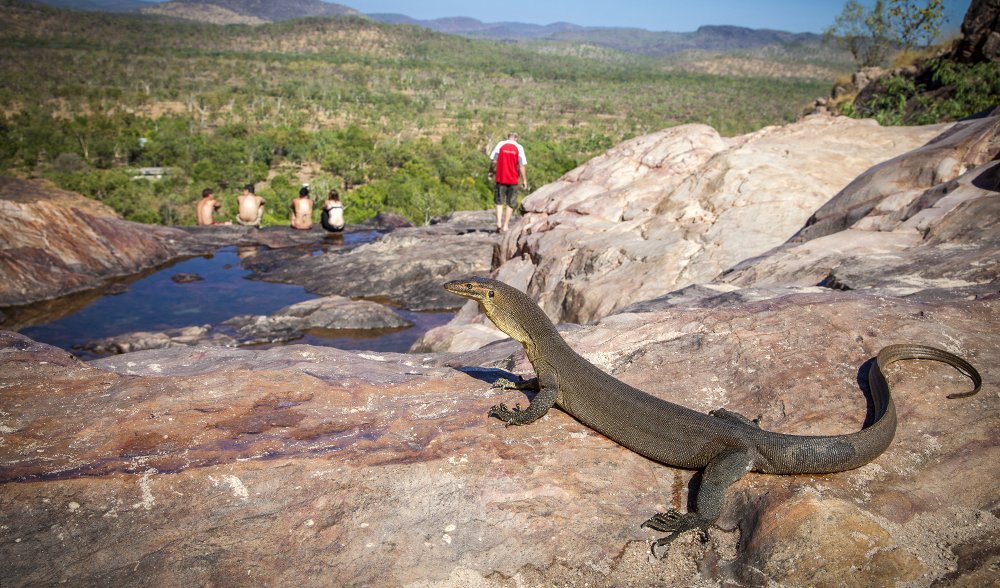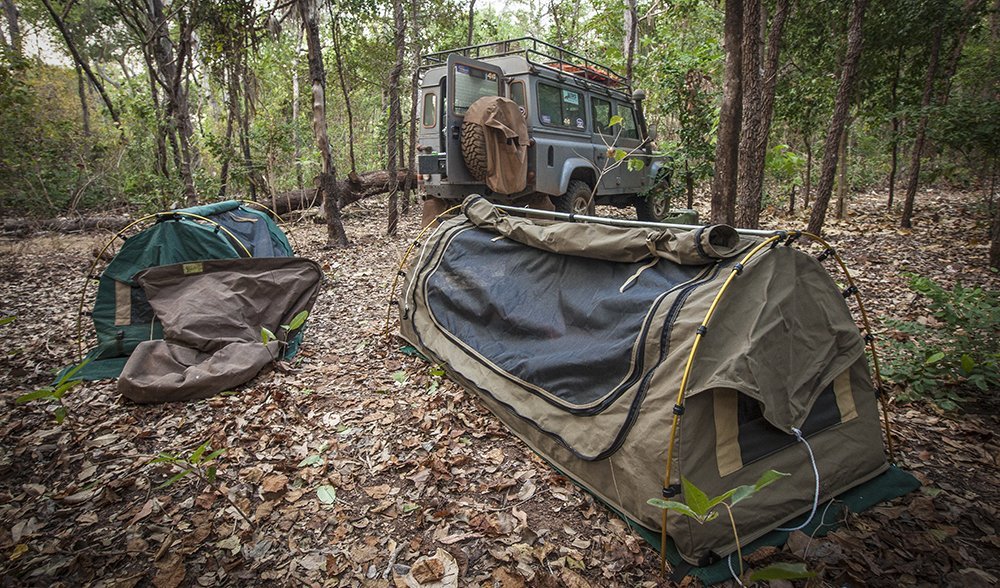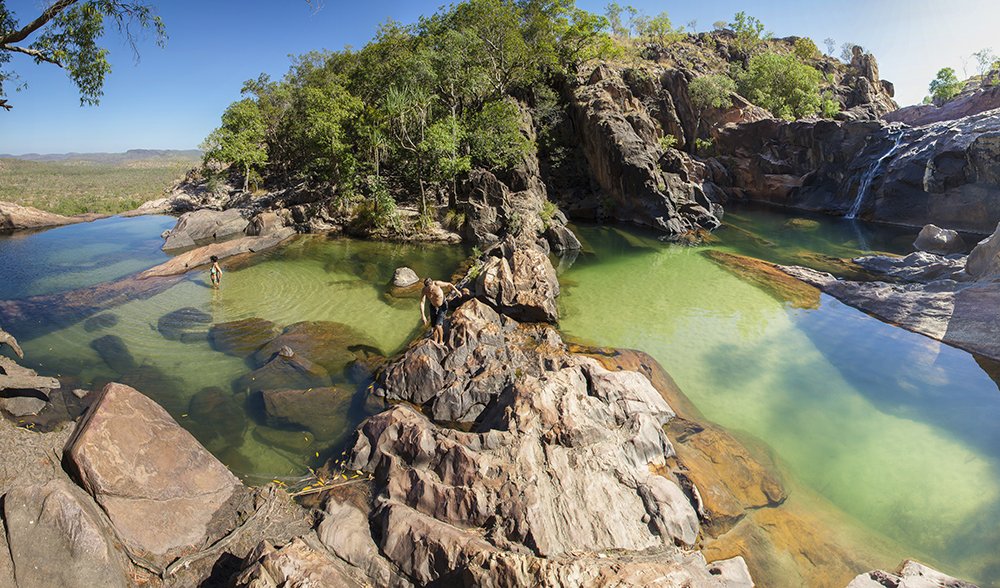COVERING AN AREA of almost 20,000 square kilometres, Kakadu is Australia’s largest national park, and it’s oh, so beautiful. Kakadu contains all you could want when it comes to a genuine Top End family adventure. From the millennia-old Aboriginal culture seemingly ingrained in every rock and waterway, through to the ease with which you can escape the larger crowds of visitors to camp in a remote bush setting, Kakadu NP has it all.
Time to dream
At a minimum, we’d recommend at least five days in Kakadu NP. The park’s size – and the fact the majority of highlights are spread well apart – means you’ll be driving a fair bit in between each campsite/destination. A clockwise route, starting from the northern entrance via Darwin, and working your way east then south to Mary River Roadhouse encompasses the best of this park.
Not long after entering the park, turn left and follow the track to West Alligator Head. This track is dry season-access only (usually from July) but takes you past the beautiful Two Mile and Four Mile waterholes (be careful of saltwater crocs near these waterways) before traversing the Manassie Floodplain and finishing on the beach at West Alligator Head (Waldak Irmbal). There is a bush campsite here (with toilets) and plenty of opportunities to explore the rocky coastline and expansive beaches. Again, be aware that this is saltwater crocodile country (the author has seen a 5m-long saltie basking in the sun at this beach) so no swimming, and be careful near any creeks or other waterways.

(Image: Justin Walker)
Rockin’ it
Returning the same way the next day, rejoin the Arnhem Highway and continue further into the park, passing the South Alligator River on the way to the Bowali Visitor Centre (also the park’s HQ). It’s well worth spending a bit of time here at the centre; the displays are fantastic plus you can get all the latest information on any road/track closures in the park. A further 39km along the Arnhem Highway is one of the park’s do-not-miss attractions: Ubirr and its exceptional rock art – plus the amazing sunset over the East Alligator River floodplains. A few hours spent at Ubirr exploring the extensive rock art sites – then sitting back on top of the Ubirr escarpment to watch the sun dip below the horizon – is a brilliant experience. There’s also a campsite at the nearby Border Store, at Merl.
Explorer mode
Heading south from Ubirr/Merl (via the Kakadu Highway) for around 60km will see you arrive at the turnoff to Nourlangie Rock (another great rock art site) and Anbangbang Billabong. This essential diversion will take at least half a day; besides the walk around the well-signposted rock art sites at Nourlangie, the easy walk around Anbangbang Billabong is a must-do. Remember to take plenty of water, sunscreen and a sunhat while tackling this walk – and keep clear of the water’s edge. All walks in Kakadu around the major sites are relatively short, not only to make them accessible, but because even in the cooler dry season it still gets quite warm. For camping, there are a couple of sites near here (Burdulba, Malabanjbandjdju and Murella Park) and, if you are driving a 4WD, you can also bush camp at Sandy Billabong, accessed via a 4WD-only track off the Nourlangie Rock Road.

Sunset over Van Dieman Gulf, viewed from the beach at West Head, in Kakadu National Park. (Image: Justin Walker)
Going deep
Speaking of 4WDs, if you are exploring Kakadu with one of these then you cannot miss the adventure of driving the track down to Jim Jim Falls at the edge of escarpment country. If not, don’t despair, as there are tour operators who can take you on this rough-and-tumble trip to one of the park’s premier attractions. It is a two-hour drive, but the effort is rewarded with a chance to swim in the waterholes near the falls (the falls themselves run nearly dry early in the dry season). For those a bit nervous of crocs (the parks authorities “clean out” swimming spots after the wet season has finished) you can scramble up the side of Jim Jim Falls to the waterholes above the cliff’s edge. A bit further south is Twin Falls, another must-see, especially as you’ve already made the effort to get down to this part of the park. Then, after all that swimming and chilling out, it’s back in the vehicle for the journey out to the Kakadu Highway and then a short drive to the Warradian Aboriginal Cultural Centre and Cooinda Lodge, right next to Yellow Water Billabong.
Close croc encounters
For avid wildlife photographers, a sunrise cruise on Yellow Water Billabong should be at the top of your list when visiting Kakadu NP. This area is packed with all the quintessential Top End photo subjects – crocs, water birds, huge lilies and a sublime sunrise over the water – and you’ll chew through a few memory cards. Saltwater crocs fear nothing so are not afraid of the boats that cruise Yellow Water Billabong, which means they usually don’t divert from their path – a path that can take them right past the viewing boats. Your boat captain will be an indigenous guide so you will gain an insight into how the original residents of Kakadu view their land and its natural inhabitants, as well as hear how their Dreaming stories relate to the creation of this magical landscape. There are few more memorable sounds and sights than that of a saltwater croc circling a drowned gum tree, and slapping its head and tail on the water as it tries to dislodge a bird in the tree’s branches. Amazing stuff.

Saltwater crocs are the masters of ambush, so be very careful near waterholes. (Image: Justin Walker)
Other highlights
Leaving Cooinda Lodge, the journey south along the Kakadu Highway continues to offer up some exciting side trips. The secluded Graveside Gorge (permit required to drive and camp here) is brilliant; Maguk (Barramundi Gorge) is accessed via a dirt road and offers excellent swimming and camping; and the twin highlights of Gunlom Falls (with its amazing plunge pools high above at the top of the waterfall, see main pic) and Koolpin Gorge (Jarrangbarnmi), which also requires a permit, are more than worth it. Both of these places buzz with the timeless spirit of Kakadu and, as the final points on our tour of this epic national park, are fitting last-night bush accommodation options. If, however, you’re keen on digs with a bit more luxury, the Wirnwirnmila Mary River Road House has motel units, caravan sites and campsites, as well as showers and all amenities (including a restaurant/shop and fuel).
The essentials
Getting there: Kakadu NP is around three hours drive – and 171km – from Darwin, via the Stuart Highway, then the Arnhem Highway.
Best time to go: The dry season is the best time to visit Kakadu NP. This is usually from June to September. Temperatures still remain on the warm side during this period, so pack plenty of sunscreen and protective clothing/apparel.
Activities: The national park has a host of activities on offer. Independent walks, interpretive guided walks and tours, indigenous cultural tours, boat cruises, photography, swimming and fishing are all available in the park.
More info: For all things Kakadu NP, go to www.travelnt.com

(Image: Justin Walker)
The ultimate adventure rig
1. Touring tent
For family camping trips, a spacious and easy to set up tent is a must. Ideally, a tent made from lightweight but tough polycotton/canvas is the best choice, purely for longevity and durability. Look for a tent that has plenty of ventilation (mesh windows and vents up high and down low to keep air moving through the interior). If possible (and if you can fit it in your vehicle) opt for a tent that features additional awnings so even if it is raining you can keep the kids entertained undercover with board games, books or other activities.
2. Roof racks/bars
A set of roof racks is at the top of our list when setting up an adventure rig. Being able to safely and securely transport watercraft (sea kayaks, canoes, paddles, etc), bikes (MTB or road bikes), or for affixing a luggage box makes racks an absolute essential. Reputable brands include Yakima, Thule and Rhino Racks, and each of these companies offer a multitude of gear-carrying systems that are very well designed and – in some cases – make loading large items, such as canoes or kayaks, up top much easier.
3. First aid kit
A first aid kit should be a permanent fixture in your vehicle, regardless of whether you’re on an adventure or not. The other permanent thing: keeping your first aid skills up to date.
4. Serviced vehicle
Book your vehicle in for a complete service and make sure you mention to the mechanic/service manager that you’re planning a big road trip. They can then check anything that needs replacing in view of the distances you plan on covering, plus they can advise on what easy-to-fit spare parts to take with you – and show you how to fit them.
5. Rooftop pod
You see these everywhere today and with good reason: being able to load bulky, lightweight gear (think: sleeping bags, clothing, etc.) in a waterproof/weatherproof roof-mounted pod means you can keep the heavier gear in your vehicle, down low in the cargo area, thus not adversely affecting your vehicle’s handling (heavy gear on your roof will change the centre of gravity of your car/wagon/4WD and is not recommended). Many rooftop pods are narrow enough that you can still squeeze in a bike rack (or two) up top as well, making the best use of your vehicle’s rooftop space.
6. Fully inflated spare tyre
Before heading off, make sure you check that your spare tyre is fully inflated and has no leaks. There’s nothing more disheartening – and potentially trip-ending – than copping a puncture and having no spare to replace it – it really is game over for your journey.
7. Portable power pack
These can be used for a variety of tasks, ranging from powering your portable fridge/freezer (if you have one), to charging your camp lights at night. Charge it up while driving, then sit back and admire the convenience of having a powered campsite, regardless of how far from “civilisation” you are.
